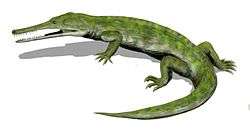Champsosaurus
| Champsosaurus Temporal range: Late Cretaceous–Eocene | |
|---|---|
 | |
| C. natator skeleton | |
| Scientific classification | |
| Kingdom: | Animalia |
| Phylum: | Chordata |
| Class: | Sauropsida |
| Order: | Choristodera |
| Family: | Champsosauridae |
| Genus: | Champsosaurus Cope, 1877 |
| Species | |
| |
| Synonyms | |
| |
Champsosaurus is an extinct genus of diapsid reptile belonging to the order Choristodera.
Description

It grew to about 1.50 m (5 ft) long,[1] though C. gigas, the largest species, reached 3-3.5 m (10–12 ft) in length.[2] Champsosaurus vaguely resembled a gharial and, like gharials, it was primarily aquatic, catching fish with its long, tooth-lined jaws. It probably swam with lateral body movements, pinning its limbs against its body to increase its streamline, just like crocodiles and the Marine Iguana. Behind the eyes, Champsosaurus's skull was very wide, where powerful jaw muscles were attached.[3] It was so specialised to life in the water that only females could come ashore to lay eggs, while males could not move on land.[4]
Discovery
Its fossils have been found in North America (Alberta, Saskatchewan, Montana, New Mexico, Texas,[5][6] and Wyoming) and Europe (Belgium and France), dating from the Upper Cretaceous to the mid Eocene. Its name means "crocodile lizard"; "Champso-" was taken from an Ancient Greek author's statement that "The Egyptians call the crocodiles χαμψαι [champsae]." Possible Champsosaurus teeth have been found in East Timor, making them exceptional in being the only Gondwanan and Australasian choristoderes known.[7]
Neonate sized Champsosaurus have been documented in the scientific literature.[8]
References
- ↑ D.Lambert, D.Naish and E.Wyse 2001, "Encyclopedia of Dinosaurs and prehistoric life", p. 77, Dorling Kindersley Limited, London. ISBN 0-7513-0955-9
- ↑ https://www.dmr.nd.gov/ndfossil/poster/PDF/Champosaurus%20gigas.pdf
- ↑ Lambert, et al. (2001).
- ↑ Yoshihiro Katsura, Fusion of sacrals and anatomy in Champsosaurus (Diapsida, Choristodera), doi:10.1080/08912960701374659
- ↑ Lehman, T.M., and Barnes, K., 2010, Champsosaurus (Diapsida: Choristodera) from the Paleocene of West Texas: paleoclimatic implications: Journal of Paleontology, v. 84, p. 341-345. Retrieved 20 September 2010.
- ↑ Lehman and Barnes (2010).
- ↑ J. H. F. Umbgrove, Structural History Of The East Indies
- ↑ Tanke, D.H. and Brett-Surman, M.K. 2001. Evidence of Hatchling and Nestling-Size Hadrosaurs (Reptilia:Ornithischia) from Dinosaur Provincial Park (Dinosaur Park Formation: Campanian), Alberta, Canada. pp. 206-218. In: Mesozoic Vertebrate Life—New Research Inspired by the Paleontology of Philip J. Currie. Edited by D.H. Tanke and K. Carpenter. Indiana University Press: Bloomington. xviii + 577 pp.